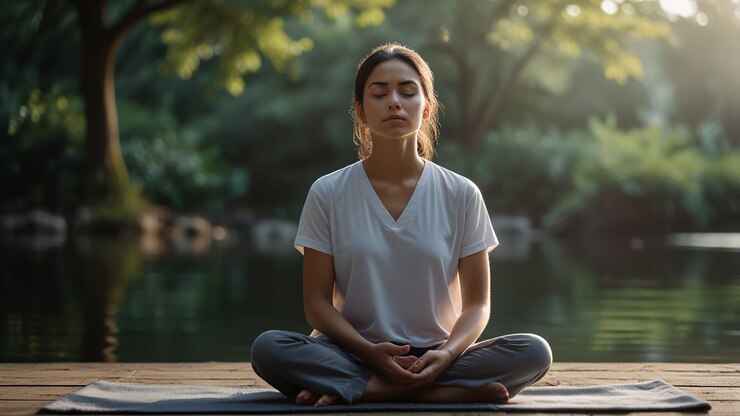Anxiety is one of the most prevalent issues in this fast-moving world. Many seek relief through medication or therapy, but another effective solution lies in somatic exercises. Somatic exercises target the connection between the mind and the body; hence, these are natural ways to handle and suppress anxiety. We will elaborate on what the somatic exercises for anxiety are, how they work, and how you can introduce them into your life to alleviate anxiety.

What are somatic exercises?
These somatic exercises are movement exercises that help heighten awareness of the sensations within the body, release tension, and thereby reduce anxiety. Whereas most traditional exercises target muscles or endurance, somatic exercises introduce motion with consciousness to heighten the mind-body connection. By paying attention to how your body feels during these exercises, you can locate areas of tension and release them, which results in both physical and mental relaxation.
How Do Somatic Exercises Help Anxiety?
Somatic exercises function to calm an overactive nervous system that happens to be running continuously when feeling anxious. You may be anxious, and your body is in this constant fight-or-flight mode- muscles tensed, breathing shallow, heart rate jacked up. In cases like this, somatic exercises for anxiety target deep breathing, gentle movement, and mindful awareness to offset such symptoms.
Such regular activity reprograms one’s body to react less hotly in critical situations and, therefore, minimizes the physical and emotional power of anxiety. Besides that, these exercises are simple and can be used anywhere, which is the simplest means by which to cope with daily anxiety.
The Science Behind Somatic Exercises for Anxiety
Such a great power of somatic exercises is based on neuroplasticity-the brain’s capability to rewire itself regarding new experiences. In this way, you show another style of reaction to stress for your brain and body while doing anxiety-reducing somatic exercises for anxiety. Eventually, it may result in changes in how you cope with anxiety for the long haul.
Various research has documented that deep breathing and body scanning in somatic exercises decrease the symptoms of anxiety through the reduction of cortisol levels in the body because of increased relaxation. These exercises combined gentle movements with mindful awareness, hence engaging both the body and mind in this stress reduction process.
Top Somatic Exercises to Help Manage Anxiety
If you are looking for some efficient somatic exercises to incorporate into your routine, then here are some of the best options:
Deep Breathing Exercises
Deep breathing is one of the most accessible and powerful somatic exercises for anxiety one to feel less anxious. Deep and slow breathing helps to send a message to your body that it can let go and relax. It will calm your nervous system and decrease all the symptoms of anxiety. To do deep breathing, you should sit or lie down in a comfortable position, close your eyes, and slowly take deep breaths in through your nose and out through your mouth.
Body Scanning
Body scanning is a somatic practice whereby you pay great attention to every part of your body and notice where tension is stored. This process lets you be more attentive to how anxiety sings in your body and lets go of the tension it produces. Trying a body scan, start at the feet and work your way up, noticing any tightness or discomfort. Pay attention to letting go of each area as you go.
Progressive Muscle Relaxation
In progressive muscle relaxation, one first tenses and then releases the tension in different muscle groups of the body. This may help someone learn to recognise physical tension and learn to release it. The procedure for PMR includes tensing the muscles in your feet for a couple of seconds and immediately releasing. Gradually work your way up through your body, working through your legs, abdomen, arms, and neck until you have relaxed each muscle group.
Grounding Techniques
These grounding exercises will help you focus on the present moment and stay attached to it. This is especially useful when one feels overwhelmed due to anxiety. An easy grounding technique is the 5-4-3-2-1, where one focuses on identifying five things they can see, four things they can touch, three things they can hear, two things they can smell, and one thing they can taste.
Who Can Benefit from Somatic Exercises?
Probably one of the most brilliant aspects of exercises somatic for anxiety is that they work well for almost anyone. Business professionals, students, or those individuals prone to chronic anxiety will find relief in these exercises. They are light enough for every type of health level and can easily be modified to fit your needs.
Moreover, somatic exercises for anxiety are best for those people who cannot handle their stress and anxiety with conventional methods. If you feel that talking therapies or medications do not completely quell your anxiety, these exercises may add in the missing link to treat symptoms of anxiety manifested physically.
How Often Should You Practice Somatic Exercises?
The thing with somatic exercises for anxiety is consistency. While you might feel some immediate relief after just one session, ultimately these kinds of exercises should be an ongoing thing in your life if you want the full benefits. If anything, try to make sure you practice somatic exercises for anxiety a couple of times a week not daily. The more you get into them, the better your body is going to learn how to release tension and remain sedated in response to troubled scenarios.
Common Mistakes to Avoid When Practicing Somatic Exercises
Although simple, there are some mistakes to be avoided with the somatic exercises for anxiety. First, do not rush through the exercises. All the practices in somatics are about mindfulness and awareness; hence, going slowly and being fully into the movement and sensations are the keys. Second, make sure your breathing is deep during the execution of these exercises. Shallow breathing will limit the effect of the exercises on behaviour and prevent thorough relaxation.
Lastly, it’s all about consistency. Somatic exercises are not something one does and then forgets about; like any kind of exercise, they take time to pay dividends in the future. Take out some fixed time every day for these exercises and make them a part of your self-care regimen.
Can Somatic Exercises Be Combined with Other Anxiety Management Techniques?
Somatic exercises could be combined with other anti-anxiety techniques: meditation, yoga, or even mindfulness practices. Many people will find that incorporating an array of techniques helps them establish a more holistic approach to managing anxiety. You will get a deeper sense of calm and well-being by being able to address the physical as well as the psychological components of anxiety.
Frequently Asked Questions (FAQs)
How long will it take for the results of somatic exercises for anxiety?
Results will vary from person to person, but many report a sense of calmness even after the first session. Whatever the case, long-term results depend upon consistency.
Can somatic exercises replace therapy or medication?
They would be nice as an addition to either of the two therapies, without essentially substituting either; they enhance the benefits of the former through the physical perspective on anxiety.
Does one need special equipment for the somatic exercises?
No, the greater part of the somatic exercises for anxiety can be done without special equipment and at home. All that is needed is a quiet place and some time to pay attention to the body and to breathe.
Final Thoughts
Making anxiety-relieving somatic exercises for anxiety part of your daily life may give you an effective and natural way to curb stress and anxiety. These exercises work on the principle of calming the nervous system and easing anxiety symptoms by letting go of physical tension and focusing on the mind-body connection. Whether you are new to somatic practices or looking to upgrade your current routine, these exercises will introduce you to techniques that will help you find your peace and put you in balance. Begin now and take your first step toward a calmer, more relaxed you.











